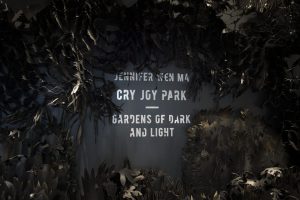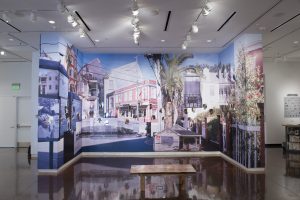


An entirely virtual exhibition, 10/10–Reflections on a Decade of Exhibitions celebrates ten years of exhibitions, partnerships, and programs produced in the Halsey Institute of Contemporary Art’s current gallery space inside the Marion and Wayland H. Cato Jr. Center for the Arts at the College of Charleston. We are spending summer 2020 taking a look back on the adventurous artists we’ve hosted and projects we’ve produced in that time. Over ten weeks, we will be taking a deep dive into each year, featuring blog posts on exhibitions, interviews with artists, and other explorations into the Halsey Institute’s past. This week we are profiling our exhibitions from the year 2019.

Jennifer Wen Ma, Cry Joy Park—Gardens of Dark and Light, installation view, 2019. Courtesy the artist. Photo: Rick Rhodes.
That year, our 2018 show Southbound: Photographs of and about the New South was on view until March, and in May we opened Jennifer Wen Ma, Cry Joy Park—Gardens of Dark and Light. The exhibition was an investigation into the construct of a utopia, inspired by the history of Charleston: a cultural and artistic capital of the American South. featured two gardens—one dark and one light, representing the duality of utopias. Ma also organized a series of community dinners that served as platforms to discuss specific issues facing Charleston, such as social justice and gentrification.

Katrina Andry: Over There and Here is Me and Me, installation view, 2019. Courtesy of the artist. Photo: Rick Rhodes.
In the fall, the Halsey Institute opened Katrina Andry: Over There and Here is Me and Me. For this show, the artist traveled to Charleston to explore how the city’s neighborhoods are being destroyed by gentrification. Her woodblock prints examine the negative effects of stereotypes on the lives of Black people and how these stereotypes give rise to biased laws and ideologies. Andry also created a large-scale photographic installation using images from around the city, transporting viewers into the tumult of rapidly gentrifying neighborhoods in Charleston.
On view at the same time was Colin Quashie’s exhibition Linked. In this body of work, Quashie juxtaposes images of well-known Black figures with other representations of artifacts to comment on stereotypes as they exist today. His goal with the work is to trace the history of the Black experience in America to its roots in slavery. For instance, in Gabriel, Quashie updates an image of Louis Armstrong, replacing his trumpet with a set of slave shackles—here pointing to the origins of jazz in the spiritual songs of enslaved peoples. His works make plain the ways in which America is built on racism and slavery.